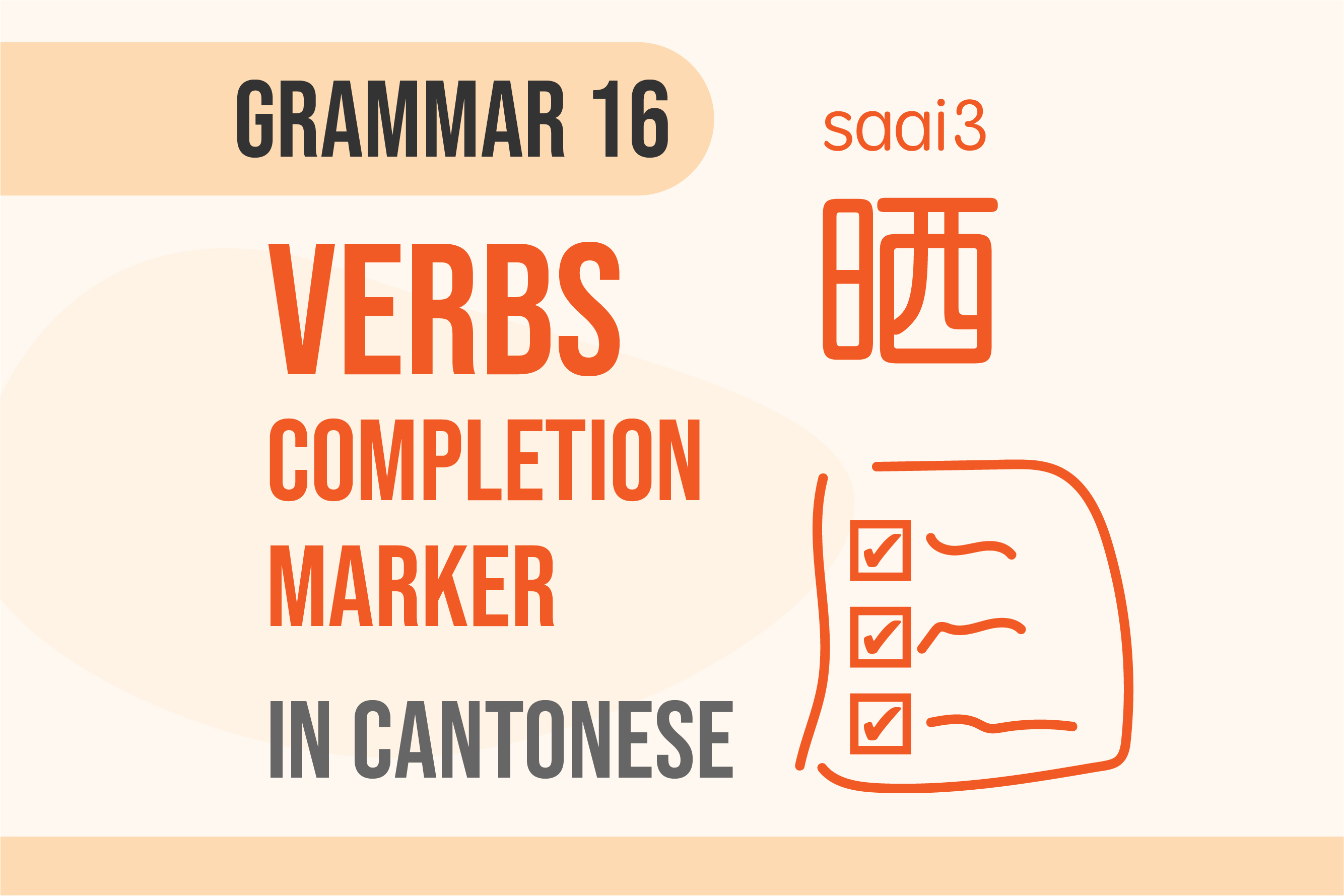Table of Content
晒 (or 曬) is one of the completion aspect markers in Cantonese. You might notice that it’s quite similar to 完 and wonder about the differences.
Generally, 晒 emphasises the effect of an action on the object, indicating that the entire object or all of the objects are impacted by the action, or that all subjects have completed the action. In contrast, 完 focuses on the completion of the action itself. In everyday conversation, they can sometimes be used interchangeably.
"晒" is often translated as "(verb +) all (+ object)" or "all of (subject) has already (verb)." Its Mandarin equivalent would be 全部 or 都.
Question
①【subject - verb - 晒 - (obj./n.) - 未 - 呀】? (to ask)
②【subject - 係唔係 - verb - 晒 - (obj./n.) - 啦】? (to confirm)
Refer to Grammar01 - 係(hai6) for the meaning of 係唔係
Structure ① is a general way of asking someone if all of the objects are impacted by the action, or all subjects have completed the action, while Structure ② is typically used when you want to confirm that all of the objects are indeed impacted by the action, or all subjects are indeed have completed the action.
(你做功課)
(You do homework.)① 你做晒功課未呀?
② 你係唔係做晒功課啦?
Have you finished all your homework?
(lit. Have you finished doing all your homework yet?)(你哋沖涼)
(You (guys) take a shower.)① 你哋沖晒涼未呀?
② 你哋係唔係沖晒涼啦?
Has everyone finished showering? .
(lit. You guys all finished showering yet?)(佢哋知道)
(They know.)① 佢哋知道晒未呀?
② 佢哋係唔係知道晒啦?
Do they all know? .
Single-Character Verbs
Verbs with Direct Object
(+ve)【subject - verb - 晒 - Object】
(-ve)【subject - 未 - verb - 晒 - Object】
(我做功課)
(I do homework.)我做晒功課啦
I have finished all my homework. .
(lit. I have finished doing all homework.)我未做晒功課呀
I have not finished all my homework.
(lit. I have not finished doing all homework yet.)(我洗碗)
(I do the dishes.)
(洗 - to wash|碗 - bowl|洗碗 generally means "doing the dishes", not just washing bowls but all types of dishwashing tasks, including plates, glasses, and utensils.)我洗晒啲碗啦
I have done all the dishes.
(lit. I have washed all bowls.)我未洗晒啲碗呀
I have not done all the dishes.
(lit. I have not washed all bowls yet.)(佢食雪糕)
(S/He eats ice cream.)佢食晒啲雪糕,一杯都冇留俾我
S/He ate all the ice cream and didn’t even leave me a single cup.
(lit. S/He ate all ice cream, ...)
Verbs with Complementing Noun
(+ve)【subject - verb - 晒 - complementing noun】
(-ve)【subject - 未 - verb - 晒 - complementing noun】
Refer to Grammar08 - Cantonese Verbs for more about complementing noun.
(佢哋瞓覺)
(They sleep.)佢哋瞓晒覺啦,靜啲啦
They’ve all gone to sleep, so keep it down.(佢哋食飯)
(They eat/ have a meal.)佢哋未食晒飯呀
They have not finished eating yet.
Double-Character Verbs
You may refer to Grammar08 - Cantonese Verbs for more about the definition of double-character verbs, separable verbs and non-separable verbs.
Separable Verbs
【Subject - [Separable Double-Character Verb] 】
Separable Double-Character Verb usually has a [Verb-Noun] structure
(+ve)【subject - [Verb - 晒 - Noun]】
(-ve)【subject - 未 - [Verb - 晒 - Noun]】
(我哋沖涼)
(We take a shower.)我哋沖晒涼啦
We've all showered.你哋仲未沖晒涼嘅?十二點啦喎!
You still have not all showered yet?It's already midnight!
Non-separable Verbs
(+ve)【Subject - [Non-separable Double-Character Verb] - 晒 】
(-ve)【Subject - 唔係 - [Non-separable Double-Character Verb] - 晒 】
(我哋考慮兩邊嘅意見)
(We consider opinions from both sides.)我哋考慮晒兩邊嘅意見,先做呢個決定
We considered every opinions from both sides before making this decision.(你了解一個人嘅背景)
(You understand someone's background.)喺你未了解晒一個人嘅背景之前,唔好太易相信佢
Don't be too quick to trust someone until you fully understand his/her background.
Comparison between 晒 and 完
你用完卷廁紙未?我都要用呀
Have you finished using the toilet paper? I need to use it too.我用晒卷廁紙啦喎
I've used up all the toilet paper.(卷 - roll, classifier for toilet paper)
你講完未呀?
Are you done talking?
(lit. Have you finished talking yet?)你講哂俾佢聽呀?
Did you tell him/her everything?
(lit. Did you tell everything to him/her to hear?)你掉完垃圾番黎記得洗手
Remember to wash your hands after you take out the trash.
(lit. Remember to wash your hands after you have finished throwing the rubbish.)我掉晒啲垃圾啦
I have thrown all the rubbish.
Another negative form of 晒
【subject - verb - 唔晒 - Object】
This pattern usually implies being unable to finish or complete all of the object.
你未食晒啲嘢喎
You have not finished all the food.我食唔晒呀
I cannot finish it all.
(lit. I cannot eat it all.)我做唔晒份卷呀
I'm not able to complete the exam.
(lit. I cannot do all the exam.)太多碗啦,我一個人洗唔晒
There are too many dishes. I cannot do them all by myself.
(lit. ..., I cannot wash them all by myself.)
